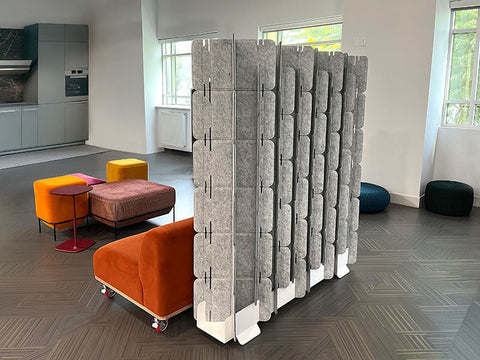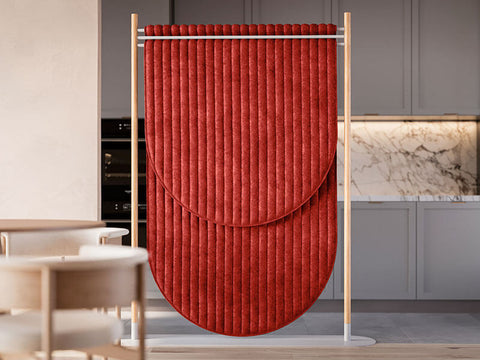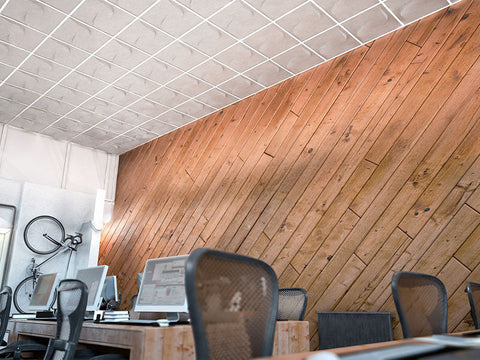If you’re working from home, sharing space with family, or carving out a quiet corner to relax, room dividers are one of the easiest and most flexible ways to create separation. But not all dividers are created equal—especially when it comes to sound.
A soundproof room divider for home office or shared living space needs to do more than just look good. It should help absorb and reduce sound, not just block sightlines. So, what materials actually work to reduce noise? And how do you choose the best room divider for soundproofing at home?
Let’s start with how sound travels—and why material choice makes all the difference.
[products ids="nomad-system-room-dividers, shift-walls-room-dividers"]
How Sound Moves—and How Materials Respond
Sound travels in waves that reflect off hard surfaces like glass, wood, and tile. That’s why open-plan homes or rooms with minimal soft furnishings often feel noisy or echoey.
Different materials interact with sound in three main ways:
Absorption: Soft, porous materials absorb sound energy, especially in mid to high frequencies (like voices or music).
Attenuation: Dense or layered materials reduce the strength of sound as it passes through.
Blocking (Transmission Loss): Thick, sealed surfaces (like actual walls) can stop sound from passing through entirely—but this isn’t realistic for portable dividers.
When it comes to room divider sound absorption, the goal is to use materials that absorb and attenuate sound—not just block visibility.

Not All Room Dividers Reduce Noise
Before diving into acoustic materials, it’s important to note that most standard room dividers do not offer any soundproofing. Common types include:
- Trifold privacy screens (wood, canvas, or paper)
- Plastic panels and plexiglass shields
- Metal mesh or framed dividers
These dividers are great for visual privacy, but they do nothing to absorb sound. In fact, many of them reflect it—making spaces feel even louder. If you’re searching for how to soundproof a room with a divider, these options simply won’t do the job.

Common Sound-Absorbing Materials
To effectively reduce noise, your room divider needs materials designed for acoustic control. Some of the more accessible options include:
Fabric panels: Heavier, layered fabrics like felt, wool, or velvet can help absorb sound, especially when hung loosely to create air pockets.
Foam inserts: Acoustic foams (like those found in recording booths) absorb echo but aren’t always attractive or sustainable.
Layered upholstery: Padded panels with a dense core and soft surface offer both attenuation and absorption—an ideal combo.
These materials work well in flexible divider systems and are commonly used in acoustic curtains, upholstered screens, or modular felt panels.
Professional-Grade Acoustic Materials
For serious performance, look for dividers that incorporate:
High-density acoustic felt: Especially made from recycled PET (rPET), this felt is both firm and porous—great for reducing reverberation.
Mineral wool or fiberglass cores: Often used in fixed wall systems, these absorb a broad range of frequencies but aren’t typically visible or decorative.
Mass Loaded Vinyl (MLV): Dense and flexible, ideal for sound blocking, though heavy and rarely used in home-friendly products.
If you want a room divider that absorbs sound and complements your space, acoustic felt made from rPET is one of the most versatile, effective, and sustainable choices available.

MIO Culture’s Sound-Absorbing Room Divider Solutions
At MIO Culture, we believe great acoustics should be modular, sustainable, and beautiful. Our freestanding room dividers are designed to reduce echo, soften ambient noise, and define flexible zones—without permanent construction or compromise.
Made in the USA from recycled PET felt, each solution combines sound absorption, visual presence, and real-world adaptability for modern living.
Shift Walls – Freestanding acoustic partitions built with our sculptural Feltforms patterns. Each configuration offers a distinct NRC rating, allowing you to tune sound absorption to your space. Shift Walls are available with base plates or caster bases, giving you the option of a stationary or mobile setup.
Nomad System Felt – A modular acoustic system made from notched felt panels that interlock to form freestanding walls of any shape or size. Tool-free and endlessly reconfigurable, Nomad is perfect for creating quiet zones, reading nooks, or flexible layout solutions at home.
Nomad Sled – A minimalist base with built-in casters that supports Nomad walls for ultimate portability. Whether you’re reworking your layout or moving between rooms, Sled makes acoustic flexibility effortless.
– Freestanding frames that suspend quilted acoustic panels for both sound absorption and spatial definition. Ideal for shared bedrooms, small apartments, or hybrid rooms, Hangout brings softness and serenity where you need it most.
Whether you’re setting up a soundproof room divider for home office focus or improving acoustics in open living areas, MIO Culture’s dividers offer the perfect balance of form, function, and environmental responsibility.
Real-World Use: How These Materials Perform at Home
It’s important to be realistic: no movable divider will fully “soundproof” a room like a wall would. But the right materials can dramatically reduce noise by:
- Absorbing echoes and reflections in open spaces
- Attenuating speech and noise between zones (ideal for shared bedrooms, workspaces, or studio apartments)
- Creating a sense of calm and privacy, especially when combined with plush furniture and soft surfaces
In practice, that means fewer distractions, clearer Zoom calls, better sleep, and more harmonious living.
Final Thoughts
If you want to improve your home’s acoustics, don’t settle for basic screens. Choose a sound-absorbing room divider that works as hard as it looks good.
From recycled materials like rPET to sculptural forms designed for real performance, the right divider can transform how your space feels, functions, and sounds.
Ready to find the best materials for your space? Explore MIO Culture’s acoustic room dividers—sustainably designed to support focused, creative, and comfortable living.





